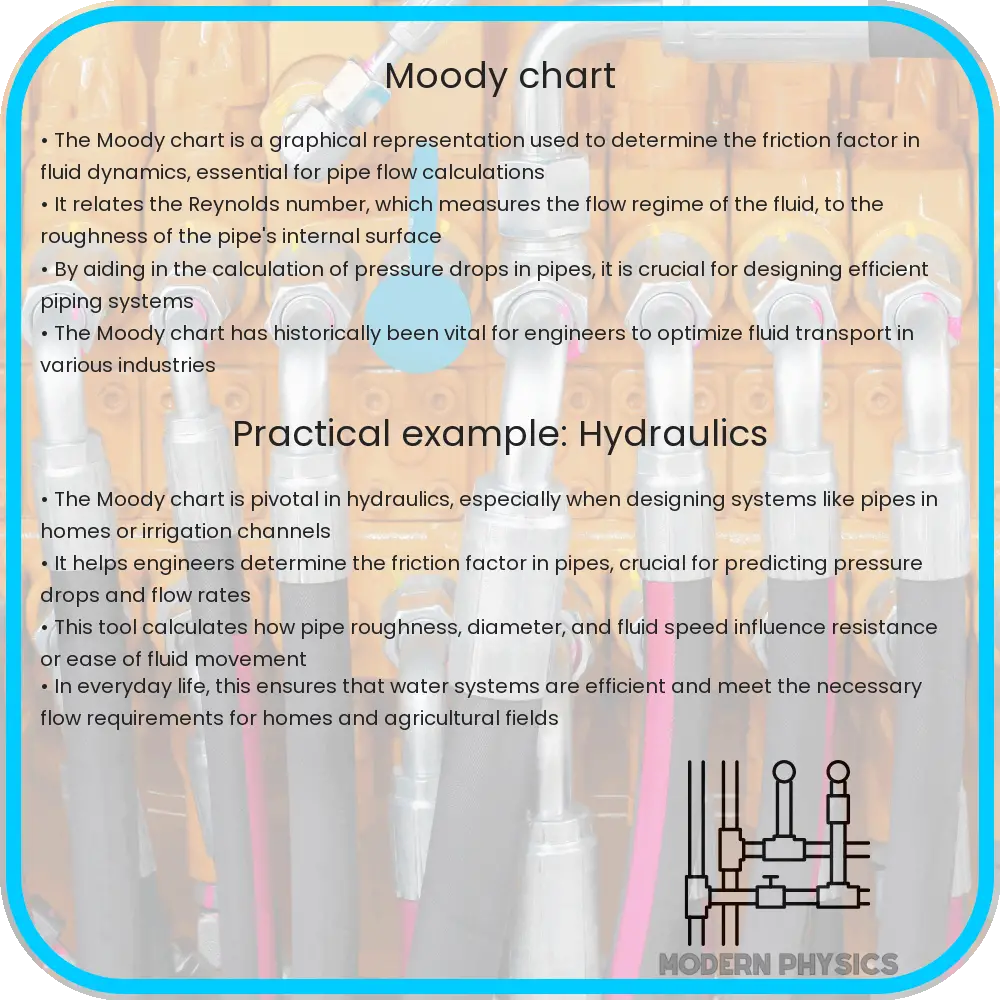A detailed guide to understanding the Moody Chart, an essential tool for analyzing pipe friction and fluid flow in hydraulic engineering.

Understanding the Moody Chart: A Guide to Pipe Friction and Fluid Flow Analysis
The Moody Chart, developed by Lewis F. Moody in 1944, is an essential tool for engineers dealing in hydraulics and fluid dynamics. It serves as a crucial aid in calculating the pressure drop or friction factor in pipes, which is a fundamental aspect of fluid flow analysis. In this article, we will explore the basics of the Moody Chart, how it is used, and why it is so important in pipe design and flow analysis.
What is the Moody Chart?
The Moody Chart graphically represents the relationship between the friction factor in a pipe, the Reynolds number (Re), and the relative roughness of a pipe (ε/D). The friction factor is a dimensionless number used in the Darcy-Weisbach equation, essential for calculating the pressure drop or head loss due to friction in a pipeline.
Why is this so important? Understanding and minimizing friction losses in piping systems can lead to more efficient system design, saving energy and reducing operational costs.
Parameters on the Moody Chart
The Moody Chart consists of the following key parameters:
- Friction Factor (f): A dimensionless number that quantifies the effect of friction resistance due to a pipe’s surface roughness and the flow’s velocity.
- Reynolds Number (Re): A dimensionless number that helps predict flow patterns in different fluid flow situations. The Reynolds number is calculated based on the fluid’s velocity, density, viscosity, and a characteristic length (in pipes, the diameter).
- Relative Roughness (ε/D): This is the ratio of the height of surface irregularities (ε) to the diameter of the pipe (D). It represents the roughness of the internal surface of the pipe relative to its size.
How to Use the Moody Chart
Using the Moody Chart involves several steps, starting with calculating the Reynolds number and determining the relative roughness. Here’s a brief overview:
- Calculate the Reynolds Number: Using the formula:
Re = (ρ * v * D) / μ; where ρ is the density of the fluid, v the mean velocity of the fluid flow, D the diameter of the pipe, and μ the dynamic viscosity of the fluid. - Determine the Relative Roughness: Measure or estimate the roughness of the pipe surface and divide it by the pipe’s diameter.
- Use the Chart to Find the Friction Factor: Locate the appropriate curve on the Moody Chart based on the relative roughness, then move horizontally from the calculated Reynolds number to intersect this curve. The intersection point vertically aligns with the friction factor on the left-hand side of the chart.
The accuracy of these calculated values is critical as they significantly impact the subsequent engineering calculations and system design.
Navigating the Regions of the Moody Chart
The Moody Chart is divided into different regions based on the flow type:
- Laminar Flow (Re < 2,000): In this region, the flow is smooth and orderly, and the friction factor is determined directly from the Reynolds number, independent of the relative roughness.
- Transition Region (2,000 < Re < 4,000): This region marks the shift from laminar to turbulent flow. The flow pattern starts to fluctuate, and the friction factor calculations can become complex.
- Turbulent Flow (Re > 4,000): In turbulent flow, the internal flow is chaotic. The friction factor depends highly on relative roughness and the Reynolds number.
Understanding these flow regions helps engineers and designers predict and manage how fluids will behave in different piping scenarios, guiding design decisions for efficiency and performance.
Applications of the Moody Chart in Engineering
The Moody Chart is not only a theoretical tool but also has practical applications in various fields of engineering:
- Pipeline Design: Engineers use the Moody Chart to determine the optimal pipe diameter and material that minimizes friction losses and maximizes flow efficiency.
- Water Treatment: In water treatment facilities, it helps in designing conduits that transport large volumes of water with minimal energy consumption.
- HVAC Systems: In heating, ventilation, and air conditioning systems, the Moody Chart assists in selecting the right size of ducts and pipes to ensure adequate airflow.
- Oil and Gas Industry: It is crucial for designing pipelines that carry crude oil or natural gas over long distances, optimizing flow and reducing pumping costs.
Thus, the Moody Chart is an invaluable resource across multiple industries, helping engineers devise systems that are both cost-effective and efficient.
Limitations and Considerations
While the Moody Chart is extremely useful, engineers must be aware of its limitations:
- Accuracy of Inputs: The precision of Reynolds number and relative roughness measurements directly affects the reliability of friction factor estimations.
- Applicability to Newtonian Fluids: The Moody Chart is primarily designed for Newtonian fluids, and its application to non-Newtonian fluids (like sludge or blood) may require additional adjustments or different charts.
- Technological Advancements: With the advent of computational tools and software, some engineers might opt for numerical methods that can provide more detailed analysis under varied conditions.
Understanding these limitations is crucial for effectively utilizing the Moody Chart in modern engineering practices.
Conclusion
The Moody Chart remains a cornerstone tool in fluid dynamics and hydraulic engineering, even decades after its development. By effectively mapping the relationship between the friction factor, Reynolds number, and pipe roughness, it provides a fundamental basis for designing efficient piping systems across various industries. Despite its limitations, the understanding and application of the Moody Chart enable engineers to make informed decisions, optimizing flow systems to meet specific requirements. As technology advances, the principles underlying the Moody Chart continue to influence modern engineering solutions, proving the enduring value of this classic analytical tool.
